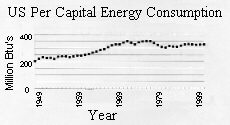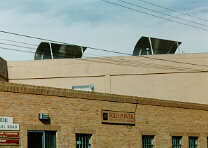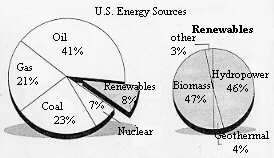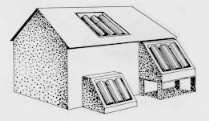As we became more sophisticated about energy's role in our society, it became evident that expenditures for energy represent the second largest flow of capital in a local economy. The largest sum of capital goes toward paying taxes. Most of our energy expenditures leave the community's economy. Making a community more energy self-sufficient means freeing up local dollars to be spent on other goods and services. And freeing up local dollars requires that we reduce our consumption of conventionally supplied energy and rely more on indigenous, renewable energy sources.
 Electricity
was first made available in our area by the Albuquerque Electric Lights Works
in 1883. In 1890, a manufactured gas plant was built to serve the community.
It was not until 1930, however, that the Southern Union Gas Company laid the
main pipeline distribution system from the San Juan Basin gas fields. Electricity
was very expensive then, and the industry in the 1900s looked toward larger,
more centralized power plants to provide the same service at less cost.
Electricity
was first made available in our area by the Albuquerque Electric Lights Works
in 1883. In 1890, a manufactured gas plant was built to serve the community.
It was not until 1930, however, that the Southern Union Gas Company laid the
main pipeline distribution system from the San Juan Basin gas fields. Electricity
was very expensive then, and the industry in the 1900s looked toward larger,
more centralized power plants to provide the same service at less cost.
In fact, the larger power plants were put into service across the country at such a fast rate that by 1920 only one out of five kilowatts was generated on site. It had become cheaper to plug into a centralized grid system than to generate power at a site close to where it was consumed. One reason for this was the introduction of the automobile, which afforded people the opportunity to settle virtually anywhere as long as they could connect with the central power source. It is interesting to note that between 1870 and 1970 the cost of oil and electricity dropped every year.
The Albuquerque area also followed this approach to centralized power plant development. Three power plants were built, the first NE of Old Town, the second at the north end of town, and the third south of town. They were built by what eventually became the Public Service Company of New Mexico (PNM) to accommodate population growth not just here, but elsewhere in the state as well. At one time, these plants served Las Vegas, Santa Fe, Belen, Bernalillo, Deming, and western parts of the state. Today these plants serve as booster stations, used only when demand for electricity is at a peak. The lion's share of power is supplied from the Four Corners area. Our power supply moved farther and farther away from the community, prompted by attractive economic conditions.
In the late 1960s and early 1970s two large regional power plants were built near Farmington, New Mexico--the Four Corners power plant and the San Juan generation station. In the 1980s PNM expanded into nuclear power by purchasing a portion of the Palo Verde nuclear plants near Phoenix, Arizona.
The OPEC oil embargo of 1973 caused a rapid rise in the cost of energy, forcing the United States to seek ways to reduce consumption and dependence on foreign oil. It also encouraged communities to analyze their resource bases in terms of energy requirements with an eye toward self-sufficiency. Energy self-sufficiency made sense from not only a national security viewpoint, but from an economic balance-of-payments perspective as well.
The energy conservation efforts of the 1970s and increased production led the way to falling energy prices in the latter half of the 1980s. By the mid- eighties the utility monopolies were beginning to break up. Starting with the telephone company and then spreading to natural gas. Electric utilities monopolies are now on the verge of being dismantled. The process, called "retail wheeling," would allow consumers to buy electricity from other sources. While wheeling would reduce energy costs it may well increase energy consumption. It is also hoped that it will encourage renewable forms of energy production.
Energy as a community issue was recognized by those responsible for developing the Albuquerque/ Bernalillo County Comprehensive Plan, which was adopted in 1975.
A few years later, information was produced by a citizen advisory board that showed how the area could change its conventional energy consumption patterns through conservation and the use of locally available renewable energy. The information was used to update the energy section of the Comprehensive Plan in 1982 and is being used by the city to guide its municipal and community energy activities. In 1994 the city council adopted "Energy Policies and strategies of the City of Albuquerque" outlining 53 strategies intended to reduce per capita energy consumption in Albuquerque by 10% in five years.
Albuquerque and the Bernalillo County area spent over one billion dollars in 1992 for energy. And if Albuquerque typifies the energy consumption patterns of most American cities, most energy expenditures leave the local economy.
Transportation in the Albuquerque/Bernalillo County area is by far the largest consumer of energy, compared with the residential, commercial, and industrial sectors. Transportation consumes about 75% of the energy dollars. Buildings in our community are generally large energy-wasters, but significant energy reductions can be achieved using existing conservation knowledge and methods.
In transportation, a mix of several conservation measures such as a switch to more fuel-efficient autos, increased car pooling, and more walking and bicycling for trips under five miles could produce large savings. There is increasing effort to switch to alternative-fueled vehicles powered by natural gas and other nongasoline fuels. Natural gas burns much cleaner than gasoline, and most of the natural gas consumed here is produced in the state.
 |
Specific measures taken by the city's Energy Management Division to save energy and money within the municipal organization include the following:
More efficiency in energy use offers tremendous potential for saving substantial
amounts of conventional energy. Current building codes and energy prices are
making new buildings far more energy efficient than older ones. New technology
is making lighting, motors, heating, and air conditioning up to twice as energy
efficient as the units they replace.
Solar heating, which was very popular during the early 1980s--partly because
of generous tax credits--can still be found as passive heating in many newly
designed residences. Photovoltaic cells, which produce electricity directly
from the sun, have become cost-effective options in an increasing number of
applications. A number of other technologies are showing great promise. Examples
are co-generation, natural gas cooling, thermal storage, and aggressive energy
management by large users.
However, our community's sources of energy will change considerably by the end of this century as the price of conventional, centralized energy sources rises, and the technology of renewable, decentralized sources advances.

Fossil Fuels - oil, coal, and gas - provide 85 percent of all energy used
in the United States.
Renewable energy sources supply just 8 percent, and most of that comes from
hydropower and the burning of biomass (wood, wood wastes, agricultural wastes
and municipal wastes).
source: U.S. Department of Energy
 Design
a "House for the Future." Try to plan the house to be as self-sufficient
as possible on an average size lot. Consider availability of materials, energy
problems, future lifestyles, and the relationship of the architecture to Albuquerque's
natural environment and cultural heritage. Is it possible to build such a
house within the city limits? County limits? What laws exist to allow this
to happen? What additional laws might be necessary, if any?
Design
a "House for the Future." Try to plan the house to be as self-sufficient
as possible on an average size lot. Consider availability of materials, energy
problems, future lifestyles, and the relationship of the architecture to Albuquerque's
natural environment and cultural heritage. Is it possible to build such a
house within the city limits? County limits? What laws exist to allow this
to happen? What additional laws might be necessary, if any? (Up to Section V, Back to Downtown Revitalization, On to Environmental Justice)